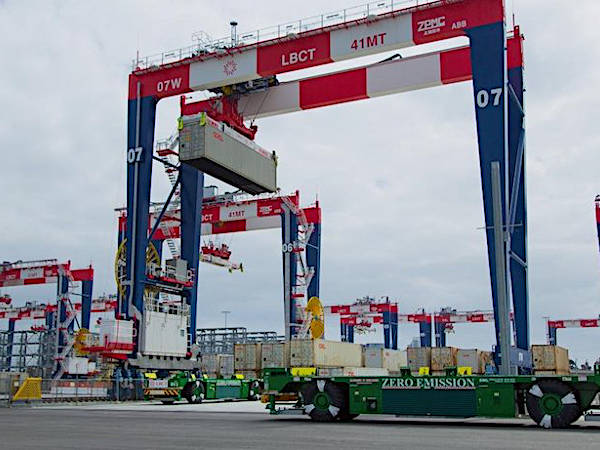Long Beach’s Hacegaba addresses West Coast market losses and PMSA criticism
The Port of Long Beach is looking at ways to win back customers recently lost to East and Gulf Coast ports and to respond to issues raised in a Pacific Merchant Shipping Association (PMSA) report, according to Noel Hacegaba, deputy executive director for port operations.
Hacegaba told AJOT that the loss of market share to Gulf and East Coast ports is “an issue we are aware of and addressing with our port partners, shippers and with the State of California.” He added, “We also recognize that the East Coast gateways particularly Savannah, Virginia and New York have spent billions of dollars upgrading their terminal facilities so as to make their ports more competitive.”
A PMSA press release summarizes key points raised in the report and “details the continuous loss of cargo from ports along the Western United States to East Coast and Gulf Coast ports. According to the paper, the West Coast port’s decline in share of cargo caused a diversion of over 668,980 containers to other states and trade gateways in a single year… In Washington State, loss of intermodal import cargo threatens the ability of growers and manufacturers to access foreign markets for their products.”
According to PMSA President John McLaurin, “The continuing loss of market share for West Coast ports, particularly Los Angeles and Long Beach, will cause economic ripples that start at the ports, move across Southern California and then affect the entire state, with the loss of good paying logistics jobs… When a cargo owner decides to change a trade route, the port, warehouse, and transportation systems all lose business, and it will take a concerted effort to bring that business back.”

A recent PMSA brief backs McLaurin’s position, “The Big Five USWC (U.S. West Coast) ports’ combined share of all containerized import tonnage discharged at U.S. mainland ports in this year’s first quarter fell from 37.9% in last year’s first quarter to 33.4% this year. In a longer-term context … the USWC share of first quarter imports has declined from 43.1% in 2010 to 33.4% this year. At the San Pedro Bay gateway (Los Angeles and Long Beach), the import share dropped from 32.0% in 2010 to 24.5%. The falloff at the NWSA (Northwest Seaport Alliance) ports was from 6.8% to 4.0%, while Oakland saw its share rise from 4.2% to 4.9%.”
The PMSA briefing paper identified three factors that caused the decline:
- California has failed to promote in-state ports and support the infrastructure needed to achieve environmental and efficiency goals.
- The “higher cost of doing business in the States of California and Washington” was responsible for the loss of cargo business.
- Work slowdowns and labor disruptions surrounding contract negotiations have raised concerns that West Coast ports are unreliable.
AgTC Shipper Switches to East Coast Ports
An example of shipper dissatisfaction with West Coast ports and recent labor disputes manifested itself at the Agricultural Transportation Coalition (AgTC) virtual meeting in May, reported on by AJOT.
Rachal DeRosier, a global accounts logistics specialist at Johnsonville Food Production, Sheboygan Falls, Wisconsin told AgTC participants that Johnsonville Food Production was diverting some exports of frozen and chilled sausage and meat products sold in Japan and Korea away from West Coast ports to East Coast ports as a result of unreliable service dating back to the 2014-2015 longshore worker slowdown.
DeRosier said that, in some cases, non-time sensitive container exports are being shipped to East and Gulf coast ports for eventual shipment to Asia. DeRosier explained that Johnsonville was taking this slow delivery route as a result of the “slow down at West Coast ports” that occurred five years ago.
In response to her comments, Peter Friedmann, AgTC executive director noted, “There is not now a slow down at West Coast ports. I realize that shippers have a long memory” and the DeRosier’s reference to a slow down by West Coast ports refers to what happened back in 2015.
Friedmann explained to AJOT that West Coast ports offer faster sailing times to China, Japan and Korea that benefit “time sensitive cargo such as beef, pork and poultry…In China, chicken feet are very popular and so we are seeing a lot of chicken feet… These protein products are major markets for us in China and must transit the most direct route in order for us to maximize profitability. Those exports are best shipped through the U.S. West Coast ports including the Ports of Los Angeles, Long Beach, Oakland, Seattle and Tacoma. If these exports were diverted to East or Gulf Coast ports, the transit times for chilled products would increase, forcing the products to be shipped as frozen instead of chilled, which lowers the market value in Asian markets. As an example, a container of chilled beef or pork might ship at $190,000 in value but when it goes frozen that value goes down to $50,000.”
At the same time, Friedmann has worked to improve relations with the International Longshore and Warehouse Union (ILWU) leadership, including inviting union officials to AgTC conferences. The result is that ILWU officials heard directly from farmers and exporters about the hardship the 2014-2015 work slowdown at West Coast ports caused to sales and livelihoods.
Time Is Money
Hacegaba noted that the AgTC exchange with Friedmann emphasized the important point that “time is money.” He added: “We recognize that cargo follows the path of least resistance and that, aside from cost, there are three principles that shippers focus on including, velocity, reliability and predictability…”
Hacegaba explained that leading companies understand how time saves money.
He cited the case of auto parts. Just in Time (JIT) automotive parts supporting U.S. manufacturing and spare parts require the shorter routes from Asia that the West Coast offers. Using a slower route would have a negative effect on the JIT system. Slower transit times are unlikely because of the cost, size, and weight of components such as engines. Doing away with JIT would come with a steep increase in capital expenditures.
Capital Investments
Hacegaba says the Ports of Long Beach and Los Angeles are proud of their clean air policies that have come in part because of tougher California regulations. He said “the Port of Long Beach is proud to be a green port.”

The process of switching from diesel-powered equipment to electric-powered equipment not only reduces emissions but the switch over to electric power and batteries also reduces costs. The investment is already paying off at the partially automated Long Beach Container Terminal where new electric-driven cranes and other cargo-handling equipment have increased productivity so that truck turn-around times picking up and dropping off containers average around 30 minutes compared to 60-80 minutes at other terminal and other ports:
“At the Port of Long Beach, we have made a $4 billion capital investment to modernize our port and make it big ship competitive. Long Beach Container Terminal, for example, remains the most advanced container terminal in the United States and as a result of electrification, it is a near zero emissions facility that has some of the best performance times in the United States.”
One example of improved productivity are the automated guides vehicles powered by batteries that are zero emission and move containers without drivers off of ships and into stacks for trucker pick-up (see photo).
Electrification supports systems integration: “as a result of the system integration at LBCT, the terminal offers a reliable appointment system for truckers which speeds up pick-ups and deliveries.”
Big Ship Capability
In addition, “LBCT is capable of handling 19,000 TEU ships and higher when other ports on the East and Gulf coasts can only handle 14,000 TEU ships maximum.”
“The picture that is emerging from the Covid-19 crisis, and the economic downturn in the United States in that we are seeing a number of blank sailings (vessel service cancellations) and a move on the part of the ocean carriers to accelerate the move from smaller ships to bigger ships. As that move continues, we are seeing more 19,000 TEU ships arriving at the ports of Long Beach and Los Angeles”
“In the case of the Port of Long Beach,four Port of Long Beach terminals can welcome mega ships. LBCT and TTI (Total Terminals International) have the capacity for 24,000 TEU ships, Pier J SSA can handle 19,000 TEU ships, and ITS (International Transportation Service) can work 14,000 TEU ships. Eventually Pier J and ITS also will be able to work 24,000 TEU vessels.So even if the costs are higher at the Port of Long Beach, the investment is paying off,” Hacegaba said.
Working with the State, Regulators, Shippers & Railroads
“We are working with Governor Newsom and the State of California to emphasize support for goods movement at our California ports … In addition, we are working with our regulators to make sure that they understand that we need to be competitive as well as being a green port. We are also continuing to engage with the beneficial cargo owners to make sure that they understand the investments that we are making to support an efficient cost competitive supply chain. We are also working with the railroads who understand that it is in their interest to provide us with the best service possible. The use of precision railroading is an example of how the railroads are providing better service that helps us at our Southern California gateway … The Union Pacific and the Burlington Northern Santa Fe railroads recognize that they have to align their performance to support our competitiveness and we continue to work with them to meet our mutual interests.”
Hacegaba notes, “within 75 miles of our port there are 2 billion square feet of warehouse space that support the transloading, distribution and trucking of cargos to their final destinations. “
Trade with China and Shifting Manufacturing to South-East Asia
“The reality is that we are the fastest ocean sailing route for much of Asia but the situation is changing. China, which has been one of our biggest customers, has seen some manufacturing shift to countries in Southeast Asia including Vietnam, Thailand and Cambodia. For these countries, imports might be faster transported via the Suez Canal to U.S. East Coast ports. We have also suffered from the trade disputes between the United States and China. The dispute has hurt our agricultural exports and we are losing market share to foreign competitors.”
Hacegaba summed up by saying “the $4 billion capital investment we have made in the Port is paying off. Increasingly, time is a big factor in JIT and we offer the fastest transit times for many parts of the United States. The challenge is to work with our partners to show them how shipping through the Port of Long Beach provides a major benefit in time and cost.”
Similar Stories
SC Ports Weather Advisory for Jan. 23, 2025
Due to inclement weather, SC Port terminals in Charleston will be closed for motor carriers on Thursday, January 23, 2025. Inland Port Dillon and Inland Port Greer will operate under…
View Article
North Carolina Ports: Winter Weather Notice
View Article
Onne Multipurpose Terminal invests in new cranes
View Article
Wallenius Wilhelmsen celebrates the grand opening of its Brunswick terminal
View Article
SC Ports Weather Advisory Jan. 22, 2025
View Article
Stacking Cranes Market Outlook 2034
View ArticleGet the most up-to-date trending news!
SubscribeIndustry updates and weekly newsletter direct to your inbox!





